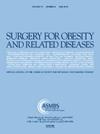Association of insurance status with postoperative resource utilization after metabolic/bariatric surgery—A multi-institutional study
IF 3.8
3区 医学
Q1 SURGERY
引用次数: 0
Abstract
Background
Postoperative emergency department (ED) use and readmissions are key quality outcome measures for Metabolic & Bariatric Surgery Accreditation and Quality Improvement Program (MBSAQIP) centers. Given increasing costs, limiting postoperative resource use is of paramount importance.
Objectives
This study aimed to investigate disparities in postoperative resource use after metabolic and bariatric surgery (MBS) across primary payor status.
Settings
Two MBSAQIP-accredited centers.
Methods
Using data from our institutional MBSAQIP dataset (2020–2023), MBS cases were identified and categorized on the basis of primary payor type. Analysis of 30-day readmissions, reinterventions, and reoperations was performed on the basis of case characteristics and stratified by payor status to examine intergroup differences.
Results
Medicaid beneficiaries were overall younger (40.4 years versus 46.5 years; P < .05) than patients with private insurance (PI) and more likely to be female. Body mass index was significantly greater for Medicaid compared with PI or Medicare (49.8 versus 47.8 versus 48.2; P < .05). Medicaid recipients had significantly greater rates of ED use (P < .0001) compared with PI and self-pay and longer operative times compared with PI and Self-Pay (144.8 min versus 126.7 versus 108.1 min; P < .05). Patients with Medicaid status also had a longer length of stay than patients with PI (1.68 days versus 1.48 days, P < .05). Despite these differences, Medicaid status was not associated with increased composite complications, composite infection, length of stay >5 days, or readmission.
Conclusions
Postoperative ED use and readmission/reoperation rates were notably higher in publicly insured (Medicare or Medicaid) patients compared with those with PI or self-pay. This highlights the importance of implementing targeted quality improvement measures to improve access to care in this population.
代谢/减肥手术后保险状况与术后资源利用的关系——一项多机构研究
背景:术后急诊科(ED)的使用和再入院是代谢与减肥手术认证和质量改进计划(MBSAQIP)中心的关键质量指标。鉴于成本的增加,限制术后资源的使用是至关重要的。目的:本研究旨在调查不同主要付款人在代谢和减肥手术(MBS)术后资源利用方面的差异。设置:两个mbsaqip认证中心。方法:利用机构MBSAQIP数据集(2020-2023)的数据,根据主要付款人类型对MBS病例进行识别和分类。分析30天再入院、再干预和再手术的病例特征,并按付款人身份分层,以检查组间差异。结果:医疗补助受益人总体上更年轻(40.4岁对46.5岁;P < 0.05),且以女性居多。与PI或Medicare相比,Medicaid组的身体质量指数显著更高(49.8 vs 47.8 vs 48.2;P < 0.05)。与PI和自费组相比,医疗补助接受者的ED使用率显著更高(P < 0.0001),手术时间也比PI和自费组更长(144.8分钟vs 126.7分钟vs 108.1分钟;P < 0.05)。医疗补助患者的住院时间也比PI患者长(1.68天比1.48天,P < 0.05)。尽管存在这些差异,但医疗补助状况与复合并发症、复合感染、住院时间≥5天或再入院的增加无关。结论:与PI或自费患者相比,公共保险(Medicare或Medicaid)患者术后ED使用率和再入院/再手术率明显更高。这突出了实施有针对性的质量改进措施以改善这一人群获得医疗服务的重要性。
本文章由计算机程序翻译,如有差异,请以英文原文为准。
求助全文
约1分钟内获得全文
求助全文
来源期刊
CiteScore
6.70
自引率
12.90%
发文量
570
审稿时长
56 days
期刊介绍:
Surgery for Obesity and Related Diseases (SOARD), The Official Journal of the American Society for Metabolic and Bariatric Surgery (ASMBS) and the Brazilian Society for Bariatric Surgery, is an international journal devoted to the publication of peer-reviewed manuscripts of the highest quality with objective data regarding techniques for the treatment of severe obesity. Articles document the effects of surgically induced weight loss on obesity physiological, psychiatric and social co-morbidities.

 求助内容:
求助内容: 应助结果提醒方式:
应助结果提醒方式:


